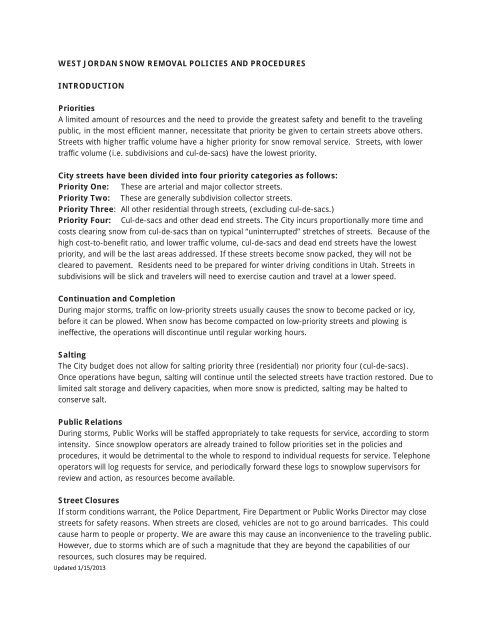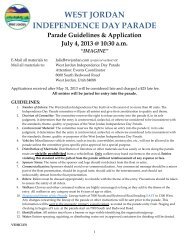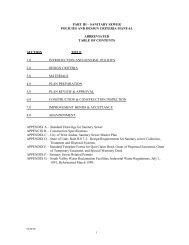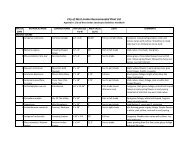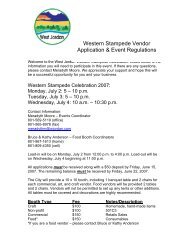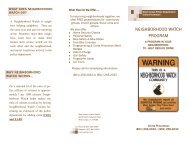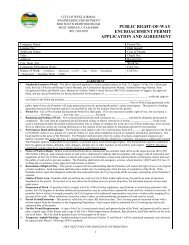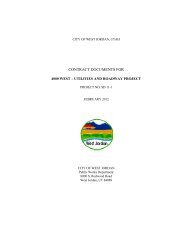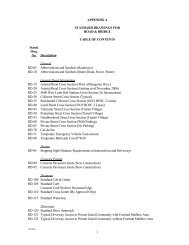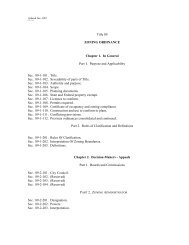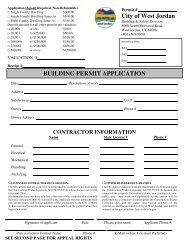Snow Removal Policy - West Jordan
Snow Removal Policy - West Jordan
Snow Removal Policy - West Jordan
Create successful ePaper yourself
Turn your PDF publications into a flip-book with our unique Google optimized e-Paper software.
WEST JORDAN SNOW REMOVAL POLICIES AND PROCEDURESINTRODUCTIONPrioritiesA limited amount of resources and the need to provide the greatest safety and benefit to the travelingpublic, in the most efficient manner, necessitate that priority be given to certain streets above others.Streets with higher traffic volume have a higher priority for snow removal service. Streets, with lowertraffic volume (i.e. subdivisions and cul-de-sacs) have the lowest priority.City streets have been divided into four priority categories as follows:Priority One: These are arterial and major collector streets.Priority Two: These are generally subdivision collector streets.Priority Three: All other residential through streets, (excluding cul-de-sacs.)Priority Four: Cul-de-sacs and other dead end streets. The City incurs proportionally more time andcosts clearing snow from cul-de-sacs than on typical “uninterrupted” stretches of streets. Because of thehigh cost-to-benefit ratio, and lower traffic volume, cul-de-sacs and dead end streets have the lowestpriority, and will be the last areas addressed. If these streets become snow packed, they will not becleared to pavement. Residents need to be prepared for winter driving conditions in Utah. Streets insubdivisions will be slick and travelers will need to exercise caution and travel at a lower speed.Continuation and CompletionDuring major storms, traffic on low-priority streets usually causes the snow to become packed or icy,before it can be plowed. When snow has become compacted on low-priority streets and plowing isineffective, the operations will discontinue until regular working hours.SaltingThe City budget does not allow for salting priority three (residential) nor priority four (cul-de-sacs).Once operations have begun, salting will continue until the selected streets have traction restored. Due tolimited salt storage and delivery capacities, when more snow is predicted, salting may be halted toconserve salt.Public RelationsDuring storms, Public Works will be staffed appropriately to take requests for service, according to stormintensity. Since snowplow operators are already trained to follow priorities set in the policies andprocedures, it would be detrimental to the whole to respond to individual requests for service. Telephoneoperators will log requests for service, and periodically forward these logs to snowplow supervisors forreview and action, as resources become available.Street ClosuresIf storm conditions warrant, the Police Department, Fire Department or Public Works Director may closestreets for safety reasons. When streets are closed, vehicles are not to go around barricades. This couldcause harm to people or property. We are aware this may cause an inconvenience to the traveling public.However, due to storms which are of such a magnitude that they are beyond the capabilities of ourresources, such closures may be required.Updated 1/15/2013
Solid Waste CollectionThe solid waste collection contractor will decide whether or not it is safe for their trucks to pick up duringor immediately following a storm. If the contractor delays pick up, the service will usually be conductedthe following day.On-street parkingCity of <strong>West</strong> <strong>Jordan</strong> Municipal Code7-3-10 : Prohibited parking for snow removalhttp://www.wjordan.com/CAttorney.aspx?pgID=3.3.1A. Specified: No person shall park a vehicle or semitrailer upon a street when it is snowing or snow ison the street from November 1 and ending April 30 of the following year.B. Obstructing <strong>Snow</strong> <strong>Removal</strong>; Impoundment: It shall be unlawful to park any vehicle or semitrailer,or permit a vehicle or semitrailer owned by that person to park in a manner that obstructs snowremoval by failing to leave adequate room for passage of plows and other removal equipment.Vehicles and semitrailers so parked are subject to impoundment as detailed in Utah CodeAnnotated section 41-6a-1408.C. <strong>Snow</strong>bound Vehicles and Semitrailers; <strong>Removal</strong>: It shall be unlawful for the owner of a vehicle orsemitrailer to allow such vehicle or semitrailer to remain standing upon any public street forlonger than forty-eight (48) consecutive hours after such vehicle has become snowbound due tosnowplows plowing around the vehicle or semitrailer. Such vehicles and semitrailers shall bedetermined abandoned. Abandoned vehicles and semitrailers shall be subject to removal andimpoundment as detailed in Utah Code Annotated section 41-6a-1408. (2009 Code)Residents can help by removing vehicles, trailers, portable basketball standards, and garbage cans fromthe street anytime snowplows are out working. <strong>Snow</strong> removal in inclement weather is challenging on a“clear” road.It is dangerous and difficult to plow streets clogged with parked vehicles. Some streets, especially cul-desacsmay not be plowed, if plows cannot safely drive down them. The most helpful thing residents can doto facilitate snow removal is to get their cars off the street, and encourage others to do the same.<strong>Snow</strong> BlowingBlowing, throwing or pushing snow from driveways and walks into the street creates additional work forsnowplow operators, and may create a traffic hazard. Some business and residents have pushed largepiles of snow onto the street, hoping it would melt quickly. The snow pile is a hazard itself, but the icecreated when the melting snow refreezes can create an even more dangerous situation. Throw snowonto landscaped areas in the yard or parking lot.Cul-de-sacsThere are over 480 cul-de-sacs in <strong>West</strong> <strong>Jordan</strong> City. It takes considerably longer to clear snow from culde-sacsthan other “uninterrupted” stretches of City streets. Because of the low traffic volume and highcost-to-benefit ratio, cul-de-sacs and dead end streets have the lowest priority. Cul-de-sacs will becleared, but it will likely be several days after a storm ends.Updated 1/15/2013
In an effort to become more efficient, crews will, when feasible, use the following standard in plowingsnow in cul-de-sacs:1. One full pass will be made around the perimeter of the cul-de-sac with a snowplow, pushing thesnow to the outside of the cul-de-sac.2. As time allows after a heavy snow, the snow will be plowed out of the center of the cul-de-sacand dispersed to the sides of the street.Sidewalks<strong>West</strong> <strong>Jordan</strong> City property owners are responsible for keeping all sidewalks along their property clear ofsnow and ice. The City requires residents to clear their sidewalks within 24 hours after a snowstorm. Citycrews are responsible for clearing sidewalks at City facilities such as the City Hall, Justice Center and FireStations. <strong>Snow</strong> removed from sidewalks and driveways should be placed in the park strip area or onprivate property and NOT in the public roads.Driveways<strong>Snow</strong> moved by a snowplow blade has no place to go but in the road right-of-way, which includesdriveways. Many times snowplowing forms snow drifts across driveway approaches, which may createhardships for some residents. However, the City possesses neither the personnel nor equipment to clearthe thousands of driveway approaches within the City. <strong>Snow</strong> removal of the driveway approaches is theresident's responsibility.Mail DeliveryIn most cases, damage occurs during the plowing process because aged posts or improperly mountedboxes are unable to withstand the rigors of the winter plowing season. The City will replace the mailboxand/or post if it is actually struck and damaged by a snowplow. Mailboxes should be installed towithstand heavy or wet snow coming off the end of the plow. The final cleaning adjacent to mailboxes isthe responsibility of the property owner. If damage occurs due to snow discharge or snow storage, theCity will not be responsible for repairs.TrailsPaved sections of the City's trail system will be NOT cleared of snow. Unpaved areas are left unplowed forvarious forms of winter recreation.Fire HydrantsThere are over 3,000 fire hydrants located throughout <strong>West</strong> <strong>Jordan</strong>. During this time of year, we canexpect that snow and snow removal activities may cause snow to be piled near fire hydrants and obstructtheir access. It is important for residents living and businesses operating near fire hydrants to keep this inmind and take action during their personal snow removal activities. It is recommended that a clear spaceof 3 feet be maintained around the circumference of fire hydrants to permit easy access in emergencies.What can I do if I am elderly and can’t shovel snow from my sidewalk or drive approach?Whenever possible, when a resident is physically unable to perform snow removal arrangements shouldbe made with a relative, friend or neighbor, for help. If there is an elderly resident who has no otherUpdated 1/15/2013
able bodied adult living with them and they need help with snow removal, please call Services for Seniorsat 801-887-1275 to request volunteer help.Safety tips• When trucks are plowing snow and spreading salt. Stay back from the vehicle a minimum of 100feet to avoid problems.• Plow trucks often have to back up. There are blind spots in the mirrors. For your safety, do notpull up directly behind them. They may not be able to see you.• When cleaning driveways or parking lots, do not put snow in the street. This can cause problemsfor other motorists.• Plow trucks generally push snow to the passenger side of the truck (right side when looking at itfrom the rear). Never attempt to pass a truck on the right since there can be much more snowon that side of the vehicle.Streets Plowed by Other AgenciesState highways are plowed by the Utah Department of Transportation. These streets include:Redwood RoadBangerter Highway7000 South from the <strong>Jordan</strong> River to Redwood Road9000 South from the <strong>Jordan</strong> River to Redwood Road7800 South from Redwood Road to New Bingham HighwayNew Bingham Highway from 7800 South to <strong>West</strong> of U-111U-111 from New Bingham Highway to the Northern City borderProperty Damage Claims<strong>Snow</strong>plowing and ice control operations can result in property damage, particularly during blizzardconditions or during nighttime snowplowing. Incidents involving contact between City equipment andprivate property typically occur within the public street right-of-way, which commonly extends beyond theadjoining sidewalk. The intent of the right-of-way is to provide for snow storage, utilities, sidewalks, andother City uses.Homeowners are permitted to place some improvements, such as mailboxes, within the right-of-way. Inthe event of damage to private property during snow removal efforts, the property owner may file aclaim with the City’s Risk Manager, by calling 801-569-5147. The damage will then be investigated todetermine if any damage is the City’s responsibility.The weight of accumulating snow may cause tree limbs to break, or other damage to structures. Suchdamage is the responsibility of the resident and his/her insurance company.Updated 1/15/2013


